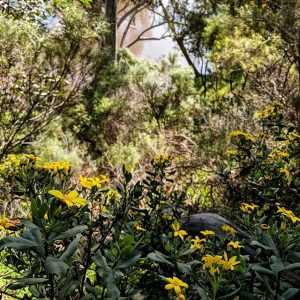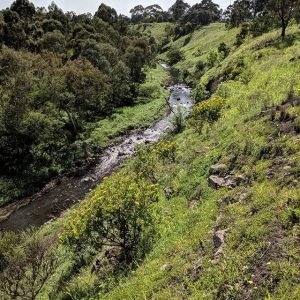Boneseed (Chrysanthemoides monilifera ssp. monilifera), this time profiling the presence of this invasive shrub aster in the inner metropolitan.
The photographs here show the species throughout escarpment areas of Yarra Bend Park (2-6), on nearby exposed scarps of the Merri Creek (7-8), and along the Clifton Hill-Jolimont railway corridor in Abbotsford (1, 9) and East Melbourne (10).
Although Yarra Bend Park is one of Melbourne’s iconic natural spaces, the superficial splendour of the river corridor belies a history of disturbance. From 1836, when cattle driven overland from NSW first crossed the river at Dights Falls, much of the parkland was extensively grazed and trampled, exploited by timber harvesters and otherwise remade.
Construction of Yarra Boulevard in the 1930s introduced retaining walls, reshaped slopes and may perhaps have included an intentional introduction of Boneseed to the parklands (if it did not merely arrive in bird droppings from nearby gardens). Boneseed appears to have been first recorded in the park in 1946, and the steep dry escarpments, denuded of much of their indigenous ground cover by a century of grazing but in some areas supporting a regenerating woodland canopy, have proven ideal for the species, allowing it to lurk, survive and rebound from cycles of weed management.
A 2000 plan by Parks Victoria reported that Boneseed in the park had been restricted to scattered individuals, that its numbers were decreasing and that the then-current control program was limiting its spread. Today, there are hundreds if not thousands of Boneseed plants along the Yarra River from Fairfield Pipe Bridge to Kanes Bridge.
Despite decades of work, no introduced biocontrol for Boneseed has achieved success in Australia. Meanwhile, the fragility of labour-based manual control is on full display this spring, devastation manifest in endless floodplain acres of Angled Onion and in these lurid golden scarps. An automatic moralism will get us nowhere with this, another species that is now part of the furniture.
View Original Post on Instagram
Search for information about Chrysanthemoides monilifera ssp. monilifera in the Flora of Victoria
View information and occurrences of Chrysanthemoides monilifera ssp. monilifera on the Atlas of Living Australia












October 20, 2020 at 6:17 PM
I’ve been pulling these intermittently until this year and the real problem is now the inaccessible places where the the seedbank survives:
– Dangerously steep banks along the river
– Along the freeway reserve/roadside
– Roadside – Kew Boulevard (private or council responsibility)
I think this can be controlled again if the above places can be accessed – anyone else interested?